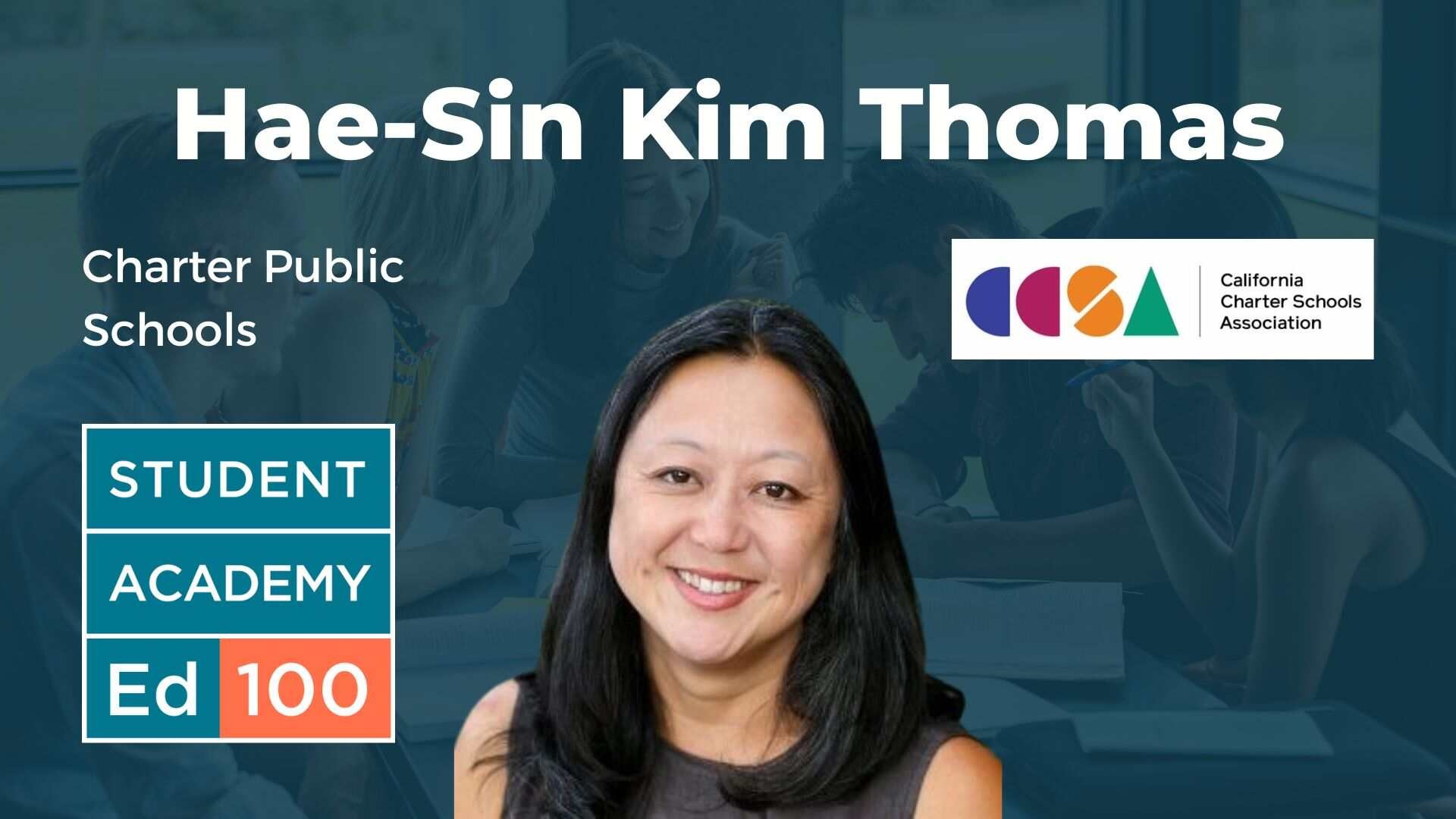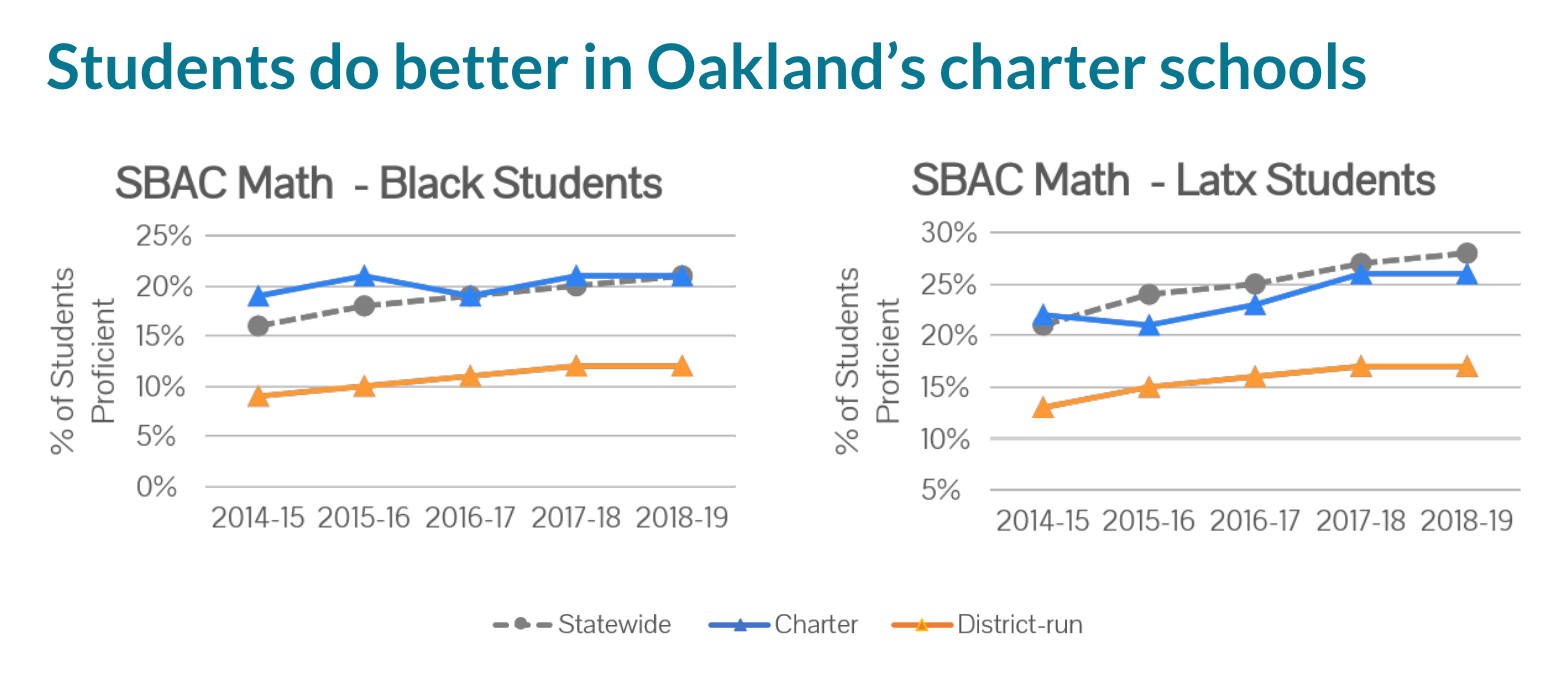Charter School Basics

What are charter schools?
What are charter schools, and how do they fit into California’s system?
Charter schools are widely misunderstood, so for years we have made an effort to help provide our readers with good information and helpful perspectives about them. Student leaders need this information, too, so we included charter schools as a recurring topic in the Ed100 Academy for Student Leaders each year.
See two videos in this post
Over the last several decades, Hae-sin Thomas has had a front-row seat in the development and evolution of charter schools in California, especially in Oakland, where she led the creation of many community schools. Even prior to the advent of charter schools, she led the district’s effort to replace massive, ineffective schools with smaller, more responsive ones. We invited Hae-sin to explain the charter school system to high school student leaders as part of the conference of the Ed100 Academy last year. The student host of the conference was Alvin Lee, the student founder of GENup.
Parts of this post are based on the video embedded below (24 minutes at 1x speed). Here are the slides that Hae-sin presented. In prior conferences for Ed100, the charter school system was explained to students by Myrna Castrejón (2020) and the late Dirk Tillotson (2021). The end of this post also includes recent comments from Jerry Brown, the former Governor of California.
But first, Hae-Sin:
About Hae-Sin Kim Thomas
Hae-Sin received the Legacy Award of the California Charter Schools Association for her role in developing school options for students in communities that were poorly served by traditional district public schools, especially in Oakland. She was the founding principal of ASCEND, one of a handful of autonomous schools recognized for providing high-quality education. She founded Education for Change Public Schools, a network of charter schools. She served as CEO of UrbanED solutions and was also the lead organizer and co-founder of Great Oakland Public Schools, an Oakland-based advocacy group.
Selected highlights of Hae-Sin’s presentation
Thomas began her presentation on a personal note about the transformative power of education. “My mom was born in Korea under Japanese occupation. She was the third daughter of the third wife of a very poor family. Just after the occupation ended, she got a free public education. She went on to get a science degree at one of the most prestigious universities, and because of that science degree was invited to come to the United States.”
Many of Hae-Sin’s formative experiences as an education leader took place in Oakland, which she describes in the first half of her presentation. She begins the latter half by emphasizing the similarities between charter public schools and traditional public schools:
|
Charter Schools |
District-Operated Schools |
|---|---|
|
Publicly-funded |
Publicly-funded |
|
Tuition-free |
Tuition-free |
|
Charter petition dictates program and is a binding contract |
Program is not often codified. No binding contract to implement a specific program |
|
Has some flexibilities to “innovate” |
Has to comply with Education Code |
|
Schools of choice |
School assignment usually dictated by address |
|
Governed by nonprofit board |
Governed by elected school board |
|
Staff not necessarily unionized |
Unions are the default in school districts |
“The differences are pretty subtle,” she said. “They’re both publicly funded and tuition-free. One interesting difference is in order to open a charter school you have to submit a petition and outline in pretty specific detail the program you're going to implement in the next five years. It's a binding contract. During those five years you must implement the program that you put into the charter petition. District operating schools don't have a contract.”
Proficiency rates Oakland charter schools are very low — but much better than district-run schools.
“One of the original reasons charters existed was because they were supposed to innovate, so they have some flexibility outside of the education code.”
“Charter schools are granted permission to operate by an elected board or a county board. The day-to-day governance of the school is actually done by a volunteer non-profit board. Another big difference — which plays out in the politics — is that charter schools are not by default unionized. In Oakland, as a result of the charter school movement, we have a Montessori school, a Waldorf Military school, a performing arts school, a French immersion school, a Mandarin immersion school — all are public free charter schools.”
Hae-sin focused a portion of her presentation on gaps in student achievement. “Our country has an enormous achievement gap that gets bigger as kids get older. The Black and Hispanic kids start behind and they never catch up!”
Charter schools, she said, have been important for these students because they are the exception to the rule. Proficiency rates for Oakland students in charter schools are very low — but they are significantly better than the rates in district-run schools.

“If they're doing better,” she said, “And they're public, and they can be shut down if they're failing — what's all the fuss about?”
|
What the fuss is about (from Hae-Sin’s slides) |
|---|
|
“Charters don’t serve the same kids… they cream.” |
|
“They are privatizing public education.” |
|
“They are NOT accountable and are often under-regulated.” |
|
“They facilitate further segregation in schools.” |
|
“They are destabilizing school districts. They are taking $ from local school districts.” |
“People will say charters are ‘destabilizing’ school districts and taking money from them,” she said, presenting the points in the table above and a slide with a collection of news headlines. “California teachers unions spend enormous amounts of money. That's what the fuss is. Whenever you fight for money, politics is involved.”
“The way schools are funded — this is really important — is the money follows the kid’s choice. 35 percent of the public school kids in Oakland have opted out of OUSD to go to charter schools. Needless to say, that's a lot of money that could have gone to OUSD, if the parents had chosen it. But the parents chose charter schools. While I am very empathetic to the financial challenge we've created by giving parents the choice to opt out of a failing school, I don't think going back to a system where parents are forced and have no choices is the answer.”
The politics of division
Hae-sin acknowledged the political challenges involved. “In Oakland, charter school people are Democrats, district public school people are Democrats, and the teachers union is predominantly Democratic. And yet we spend more time fighting than we do coming together to say ‘wow, we have a real crisis in education in Oakland, how shall we solve it — let's look at the data!”
“My larger message to you all is let's focus on the real problem at hand and actually try to go into a solution space instead of pointing fingers and fighting for very limited resources — that's what I hope becomes the message that you all walk away with from this presentation. It’s not that you're pro-charter or anti-charter but that you're pro-kid and pro-equity.”
Jerry Brown’s support for charter schools
Many charter schools in California opened during the years when Jerry Brown was governor of the state. He was recently interviewed about his support for the policy by Myrna Castrejón. The four-minute video below helps explain his thinking about the policy.
More about charter schools
A great deal about charter schools can be found on Ed100. The main lesson about them is Lesson 5.5. To find even more, use our search function!
Tags on this post
All Tags
A-G requirements Absences Accountability Accreditation Achievement gap Administrators After school Algebra API Arts Assessment At-risk students Attendance Beacon links Bilingual education Bonds Brain Brown Act Budgets Bullying Burbank Business Career Carol Dweck Categorical funds Catholic schools Certification CHAMP Change Character Education Chart Charter schools Civics Class size CMOs Collective bargaining College Common core Community schools Contest Continuous Improvement Cost of education Counselors Creativity Crossword CSBA CTA Dashboard Data Dialogue District boundaries Districts Diversity Drawing DREAM Act Dyslexia EACH Early childhood Economic growth EdPrezi EdSource EdTech Education foundations Effort Election English learners Equity ESSA Ethnic studies Ethnic studies Evaluation rubric Expanded Learning Facilities Fake News Federal Federal policy Funding Gifted Graduation rates Grit Health Help Wanted History Home schools Homeless students Homework Hours of opportunity Humanities Independence Day Indignation Infrastructure Initiatives International Jargon Khan Academy Kindergarten LCAP LCFF Leaderboard Leadership Learning Litigation Lobbyists Local control Local funding Local governance Lottery Magnet schools Map Math Media Mental Health Mindfulness Mindset Myth Myths NAEP National comparisons NCLB Nutrition Pandemic Parcel taxes Parent Engagement Parent Leader Guide Parents peanut butter Pedagogy Pensions personalized Philanthropy PISA Planning Policy Politics population Poverty Preschool Prezi Private schools Prize Project-based learning Prop 13 Prop 98 Property taxes PTA Purpose of education puzzle Quality Race Rating Schools Reading Recruiting teachers Reform Religious education Religious schools Research Retaining teachers Rigor School board School choice School Climate School Closures Science Serrano vs Priest Sex Ed Site Map Sleep Social-emotional learning Song Special ed Spending SPSA Standards Strike STRS Student motivation Student voice Success Suicide Summer Superintendent Suspensions Talent Teacher pay Teacher shortage Teachers Technology Technology in education Template Test scores Tests Time in school Time on task Trump Undocumented Unions Universal education Vaccination Values Vaping Video Volunteering Volunteers Vote Vouchers Winners Year in ReviewSharing is caring!
Password Reset
Search all lesson and blog content here.
Login with Email
We will send your Login Link to your email
address. Click on the link and you will be
logged into Ed100. No more passwords to
remember!














Questions & Comments
To comment or reply, please sign in .
Caroline Grannan April 11, 2023 at 7:34 am
Neil Landers April 10, 2023 at 3:21 pm